These days, video is basically the primary form of content across all social platforms. But if you want your video strategy to succeed, you have to keep an eye on your social video metrics.
Like other social analytics, video metrics show you what’s working, what isn’t, and any opportunities for future wins. But those might look a little different from the analytics you’re used to.
Keep reading for a full breakdown of the social video metrics you need to monitor, including platform-specific numbers and how to interpret the data.
Bonus: Get a free social media analytics report template that shows you the most important metrics to track for each network.
What are social video metrics and what can they tell you?
Social video metrics, like views, retention rate, and average watch time, allow you to track and improve the performance of your video content.
Like metrics for other types of social posts, video metrics provide insight into whether or not you’re reaching people, if followers are interacting with your videos, and how engaged your audience is.
There are many video metrics to track, from view count to average watch time to follower growth. But to get the most out of your video strategy, the key is to pick the right ones for your brand.
And the “right” ones all depend on your goals. What are you trying to accomplish with your video?
Are you trying to increase awareness around a product launch? In that case, you want to monitor your video reach to make sure people are seeing your content.
Maybe you’re simply trying to increase your audience size. That means you want to keep a close eye on your followers after you release your video.
Does the video tell your viewers to like, comment, and subscribe (a.k.a every single YouTube video ever)? You’ll want to make sure your engagement numbers are up to see if your CTA is working.
The top 7 social video metrics to track
To find out which video KPIs are worth tracking, I asked Eileen Kwok, who manages Hootsuite’s social video content, for her insights.
Here are the top social video metrics that can tell you the most about your performance across all channels.
1. View count
The most important (and obvious) metric to track is your video views.
Each video you post will have a view count. Not only does this metric tell you how many accounts your video reached, but it’s also an indicator of whether or not your video will go “viral,” according to Kwok.

“From an awareness standpoint, we care about how widely shared the video is to see if this was something the algorithm favored,” says Kwok.
Plus, Instagram’s recently made views the primary metric for all content, not just Reels, so you know it matters to the platforms.
If you have a consistent video view rate, you know your videos are regularly reaching people — congrats! You’re in a pretty good position.
But if your views are all over the place, it’s worth analyzing the ones that have generated the most views to figure out what made them stand out.
Here’s what counts as a view by platform:
- Facebook: 3 seconds or more
- Instagram: 3 seconds or more
- YouTube: 30 seconds or more
- TikTok: The second your video starts to play
- LinkedIn: 2 seconds or more while the video is at least 50% on screen
- X (Twitter): At least 2 seconds with at least 50% of the video on screen
- Snapchat: 1 second or more
2. Engagement
Engagement is a big category, but it’s worth considering as a whole.
Generally, engagement describes how your audience interacts with your content, and people like Instagram’s Adam Mosseri are pretty clear that engagement metrics are among the most important to track.
(Psstt: Adam, thanks for being so transparent about these numbers!)
Video engagement includes likes, comments, shares, and saves, and can indicate how much your video resonated with viewers.
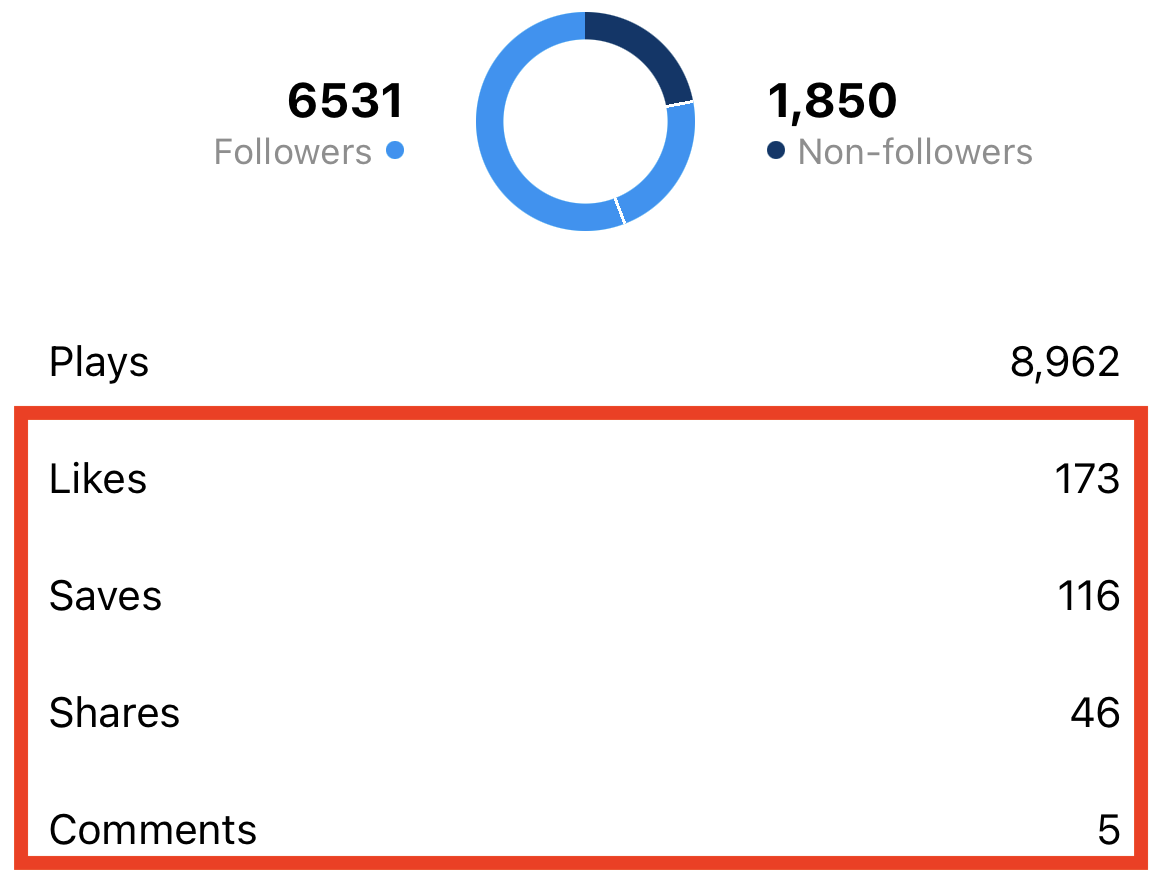
You can review these metrics as a whole in the platforms themselves (like the screenshot above) or you can check out even more information in a social media tool like Hootsuite.
Reviewing your video engagement on its own is useful, but it can be helpful to zoom out a little, too. Check out average engagement rates by industry to see where you stand, or use Hootsuite Analytics to compare your performance to your top competitors.
With Hootsuite’s social media benchmarking, you can find out how others in your industry are doing on social and compare your results with just a few clicks.
You can set up custom timeframes, switch between networks — Instagram, Facebook, X, LinkedIn, and TikTok — and look up benchmarks for metrics like engagement rate, clicks, shares and more.

You will also find resources to improve your performance right in the summary section:

And, if you need to present your results to your team, boss, or other stakeholders, you can easily download your comparison report as a PDF file.
If your engagement is low, you may need read up on social video best practices to improve the quality, format, and overall strategy behind your videos.
3. Average watch time
Average watch time tells you how long viewers watched your video and when they dropped off. This can be a very telling metric if you want to understand how your video content is performing, says Kwok.

“If you post a one-minute video and the average watch time is three seconds, it’s an indicator that the start of your video is missing a hook,” she points out. “If you posted a three-second video and the average watch time is 5 seconds, that means the user watched the video more than once.”
This metric also gives you a better idea of how long your videos should be to capture your specific audience.
Here are some platform-specific metrics related to watch time:
- Average play time: The average time a video was played or replayed.
- Minutes viewed: The total number of minutes viewers watched your videos for a date range.
- 1-minute video views (only for videos 1 minute or longer): The number of times your video played for at least 1 minute.
- 10-second video views (only for videos 10 seconds or longer): The number of times your video played for at least 10 seconds.
- 3-second video plays: How many users watched your video for at least 3 seconds.
- View rate: The number of views and impressions multiplied by 100
- Views at 25%: How many times users watched a quarter of your video.
- Views at 50%: How many times users watched half your video.
- Views at 75%: How many times users watched ¾ of your video.
- Completions: How many times users watched 97% or more of your video.
- Completion rate: How many times users completed your video.
TikTok
- Average watch time: The average amount of time people spent watching your video.
- Video completion percentage: The number of times the video has been watched in full, as a percentage of viewers.
YouTube
- Minutes watched: The total number of minutes viewers watched your video.
- View duration: The average length of video playbacks.
- View percentage: The average percentage of a video watched during a video playback.
4. Follower growth rate
Audience growth rate is an essential social media metric for every platform and content type. Follower growth measures the total number of new followers you receive in a select time period.
On YouTube, for example, you can find this under Analytics, then Audience.

If one of your video strategy goals is to grow your audience or increase brand awareness, then it’s important to keep an eye on this metric after you post a new video.
Think of your followers (or subscribers) as your fans, because that’s what they are. Pay close attention to the content that appeals to your core audience and results in a rise in subscribers. By catering to their needs, you’ll be able to improve all of your key social video metrics.
5. Shares
Shares are when viewers send your video to another user through DM or share it on their own page or story. And yes, while shares technically fall under engagement, they’re worth tracking as their own video metric.
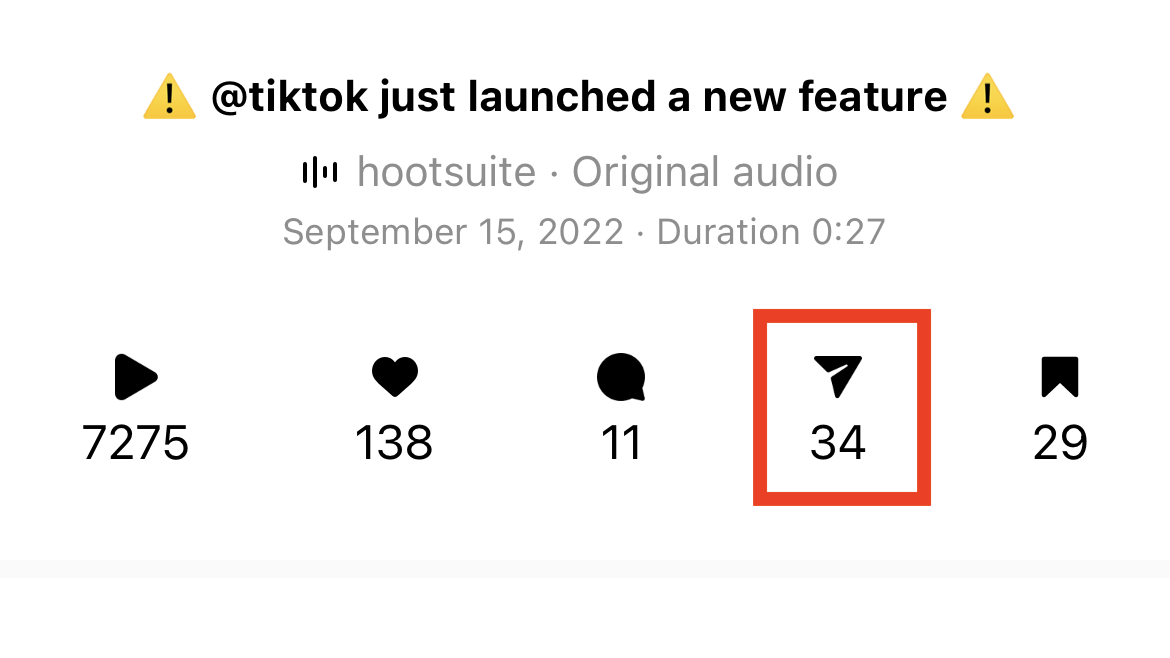
Shares indicate that your video resonated with the viewer enough for them to share it with someone else. But shares are also an important metric from a consideration standpoint, according to Kwok.
“Shares are a form of word-of-mouth marketing,” she says. “Users are more likely to pay attention to content that’s shared by their peers.”
Plus, Instagram’s been pretty open about the importance of creating shareable content. If your videos are getting more shares, they’re more like to get priority in the recommendation algorithms.
6. Saves
Saves are technically another engagement metric, but they can tell you a lot about how your audience receives your content.
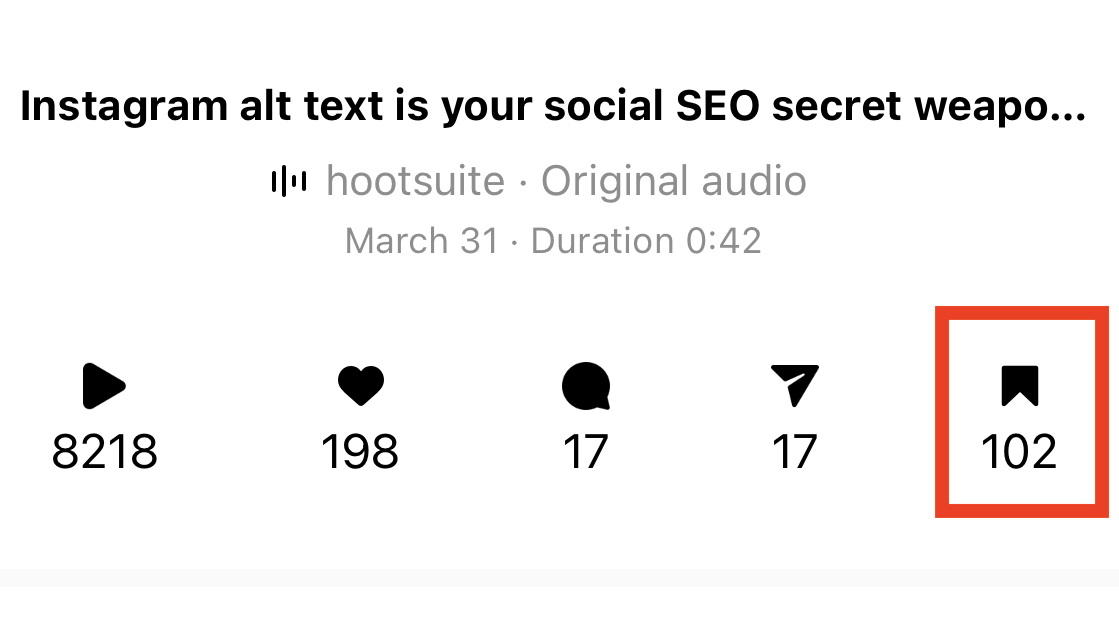
When someone saves your video, it tells you that the video resonated with them. It’s an extra step to save a video, but it means that they plan on coming back to it and rewatching it.
Taking a closer look at which Reels, TikToks, Shorts and other social videos are saved most often can tell you a lot about what your audience finds most valuable.
7. Traffic source
Understanding how users are finding your videos is also important to your video strategy. The traffic source metric can tell you where to spend more time and resources distributing your video content.
On YouTube, for example, you can find traffic source types in your analytics dashboard. This metric tells you how viewers found your video, both within YouTube and from external sources.
If you’re posting on TikTok, it’s important to see how much traffic comes from the FYP, says Kwok.
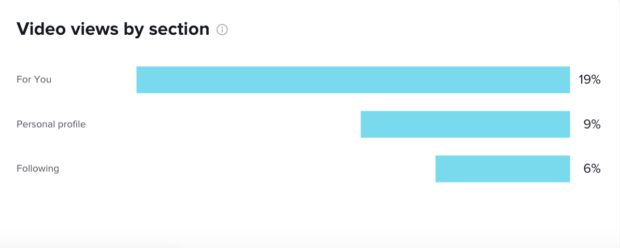
“This indicates that the keywords used in the video were picked up by the TikTok algorithm, and your video was pushed to a wider audience,” she says.
How to track and improve video performance using Hootsuite
Want to take your social videos to the next level? You need to know what your goals are before you figure out which video metrics to track.
It’s likely that your videos are trying to do a combination of a few things — and that’s great! In those situations, you’ll want a good tool to keep an eye on all those metrics across different platforms.
With Hootsuite Analytics, for example, you can create customizable dashboards to track your video performance, including organic as well as paid ad performance.
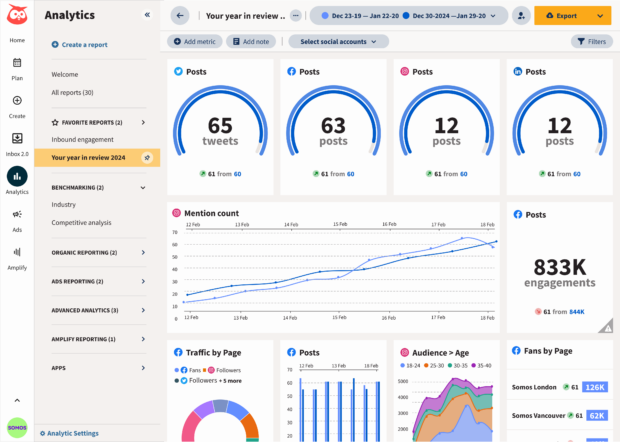
Your dashboard can house your video performance across all networks so you can see metrics like video views in one dashboard.
Ready to put your video marketing plan into action? Upload, schedule, publish, promote, and monitor your social videos from one platform — Hootsuite makes it easy.
Do it better with Hootsuite, the all-in-one social media tool. Stay on top of things, grow, and beat the competition.
The post 7 Social Video Metrics To Help You Make Better Content appeared first on Social Media Marketing & Management Dashboard.




This post highlights an essential aspect of content creation in today’s digital landscape. I’ve noticed that simply having high view counts isn’t enough; understanding metrics like retention rates often reveals deeper insights into audience engagement. For instance, I’ve experimented with varying video lengths across platforms, and I found that shorter, more punchy videos tend to retain viewers better compared to longer narratives, especially on platforms like TikTok.
You bring up a really interesting point about retention rates being a key metric in gauging audience engagement. It’s fascinating how audience preferences can shift so quickly, especially with platforms like TikTok where the content is often heavily curated for brevity and impact. I’ve noticed that with my own content as well; it seems like viewers are more willing to engage with shorter pieces that get straight to the point.
You bring up a really interesting point about retention rates being a key metric in gauging audience engagement. The way platforms like TikTok have influenced content creation is certainly significant. It’s almost like we’re in a new age of storytelling where brevity reigns supreme. I’ve noticed the same trend; it feels like viewers appreciate content that cuts through the noise and delivers value quickly.
You hit the nail on the head. The shift toward short, engaging content has definitely changed how storytelling works. TikTok is more than just a platform; it’s shaping how creators think about their audience’s attention spans. In this fast-paced environment, getting to the point quickly isn’t just a preference—it’s a necessity.
You make an excellent point about the importance of retention rates in understanding audience engagement. It really shifts the perspective on what success looks like in content creation these days.
I found this article really insightful, especially as it dives into successful and failed marketing campaigns that can teach us a lot about audience connection and engagement strategies.
‘The 20 Best & Worst Marketing Campaigns of 2021 (The Small Business Version!)’
https://localseoresources.com/the-20-best-worst-marketing-campaigns-of-2021-the-small-business-version/.
You raised a great point about retention rates truly shifting our understanding of success in content creation. It’s fascinating how metrics like these can reveal so much about genuine audience engagement, almost more than just views or likes ever could. Success really is evolving as audiences become savvier and more selective about the content they consume.
You’ve touched on something that’s becoming increasingly evident in the world of content creation. When we look at retention rates, it’s clear we’re measuring more than just a fleeting glance; we’re assessing true engagement and a connection with the audience. It’s almost like shifting from a surface-level understanding of success to something much deeper.
Absolutely! If you’re interested in exploring more about how retention rates can reshape your content strategy, check out this insightful resource that delves deeper into audience engagement trends.
https://localseoresources.com/ninja
You’ve nailed a really important point about retention rates. It’s fascinating how the metrics can tell a different story than just view counts. I’ve also dabbled with video lengths, and it’s interesting to see how particular platforms shape viewer expectations. I’ve found that with shorter formats, there’s a real urgency to deliver value quickly, which almost creates a challenge to get creative with storytelling.
You bring up an interesting perspective on retention rates and viewer expectations. It’s true that metrics like view counts can only tell part of the story—retention rates provide a more nuanced picture of what’s really resonating with an audience. I’ve also noticed how the shift toward shorter formats impacts content creation; there’s definitely a balancing act between brevity and depth.
You’ve touched on something that I find really intriguing—how retention rates reveal what truly engages viewers beyond just those big view counts. It got me thinking about how different platforms have evolved and how they’re reshaping content strategies.
You’ve raised an interesting point about retention rates and how they can sometimes tell a fuller story than sheer view counts. I’ve noticed that platforms are increasingly leaning into metrics that measure engagement over mere numbers. It makes you wonder about the evolving nature of content and what truly resonates with audiences.
You’ve hit on something really important with retention rates and their role in the bigger picture of content engagement. It’s fascinating how we’re seeing a shift towards valuing how long someone stays connected to a piece of content rather than just the raw number of views it gets.
You’ve highlighted a key aspect that often gets overlooked—how viewer engagement can be far more telling than just the numbers. Shorter formats definitely push us into a space where every second counts, and it’s a real art to craft a message that resonates quickly. I’ve noticed, too, that platform algorithms often favor this rush for rapid engagement, which can shift how we approach storytelling.
You’ve touched on a really insightful aspect of content creation. Metrics like retention rates often reveal nuances that aren’t immediately obvious when you just look at view counts. It’s clear that understanding how audiences engage with videos can transform the way we approach storytelling.
You hit the nail on the head with your observations about viewer engagement. It’s fascinating how we often get wrapped up in those big view counts, but as you mentioned, retention rates tell a whole different story. Your experiments with video lengths are really interesting.
The emphasis on video content within social media strategies is both a reflection of evolving consumer preferences and the inherent storytelling capabilities that video provides. It’s fascinating to see how platforms have adopted and enhanced video features, making it essential for brands and creators to adapt their strategies accordingly.
You’ve captured an important aspect of the current landscape. As video content continues to dominate, brands and creators face the challenge of not just keeping up but also finding authentic ways to engage audiences. The beauty of video lies in its ability to convey emotions and narratives that text alone often struggles to deliver.
“To explore how you can effectively harness the power of video in your strategy, check out our latest insights here!”
https://localseoresources.com/ninja
You hit on something really important with the storytelling aspect of video content. It really does allow brands and creators to connect with audiences on a deeper level. I’ve noticed that even in areas like health and wellness, for instance, short, engaging videos can convey complex information—like mindfulness techniques or nutritious cooking methods—in a way that static posts simply can’t.
Your breakdown of social video metrics highlights a critical aspect of content creation that often gets overlooked. In today’s digital landscape, where attention spans are shorter than ever, understanding the nuances of video performance is essential for brands and creators alike.
You’ve hit on something really important. The way we consume content has transformed so rapidly, and it feels like keeping up with viewer expectations can be quite the challenge for creators. I often think about how platforms like TikTok and Instagram have shifted the landscape, prioritizing bite-sized content that demands immediate engagement. This shift certainly puts pressure on brands to get creative with storytelling in such a condensed format.
I completely agree with your point about the importance of video performance; it reminds me of a recent read on effective social media monitoring tools that really delves into how brands can enhance their approach to content creation.
‘8 Top Social Media Monitoring Tools and Why You Need Them’
https://localseoresources.com/8-top-social-media-monitoring-tools-and-why-you-need-them/.
You bring up a solid point about the fast-paced world of content consumption. It’s like trying to catch a greased pig at a county fair—just when you think you’ve got it, it wiggles away. TikTok and Instagram really have shifted the narrative, leaving brands scrambling to keep up with those tiny little attention spans. If only crafting a compelling story was as easy as flipping a switch, right?
I completely agree that video metrics are crucial for understanding our audience’s engagement. It’s fascinating how different platforms require us to approach analytics in unique ways. For instance, I’ve noticed that while high view counts can be thrilling, it’s really the retention rate that tells the real story about a video’s impact.
It’s fascinating how crucial video metrics have become in shaping content strategies. I recently applied some of these insights to my own social media campaign for a local non-profit, focusing on viewer retention and engagement. It was a game-changer! I discovered that our shorter, more dynamic clips had a significantly higher retention rate compared to longer ones, which showed me the power of concise storytelling.